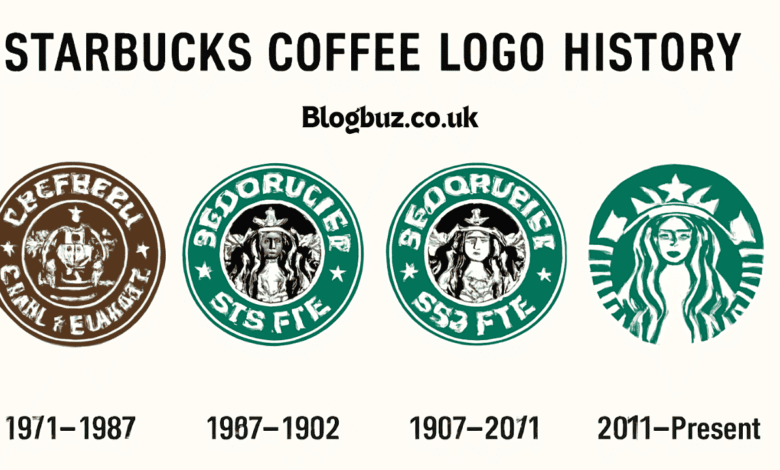Starbucks Coffee Logo History: From Mythical Siren to Global Icon

The Starbucks coffee logo history is not just a tale of graphic design evolution—it’s a visual chronicle of how a small coffee shop in Seattle transformed into one of the most recognized brands in the world. The logo always reflects Starbucks’ mission, identity, and marketing ambitions. From its original depiction of a siren to today’s sleek, minimalist design, the Starbucks logo has undergone several transformations while retaining its mythical charm. In this comprehensive article, we will examine the fascinating journey of the Starbucks logo—its origins, the meaning behind the siren, the timeline of changes, controversies, cultural significance, and how the logo became a globally recognized symbol.
The Origins of Starbucks: Where It All Began
Starbucks was founded in 1971 by three partners—Jerry Baldwin, Zev Siegl, and Gordon Bowker—in Seattle, Washington. Initially, it was not the coffee empire we know today, but a local store that sold high-quality coffee beans and equipment. The name “Starbucks” was inspired by Starbuck, the first mate from Herman Melville’s famous novel Moby-Dick, aligning with the founders’ desire to evoke seafaring traditions and the allure of the high seas.
This nautical theme influenced the name and the logo—a critical aspect of their brand identity.
The First Starbucks Logo (1971–1987): The Brown Siren
The original Starbucks logo featured a twin-tailed siren (mermaid) derived from a 16th-century Norse woodcut. Designed by Terry Heckler, this version was brown and depicted the siren in full, topless, with exposed breasts and two flowing tails. It was detailed, raw, and artistic, reflecting the company’s rustic origins and passion for traditional coffee sourcing.
The siren was chosen as a metaphor: just as the sirens of Greek mythology lured mariners to their doom, Starbucks hoped to attract customers with its coffee’s irresistible aroma and flavor.
Key Features:
- Brown color scheme
- “Starbucks Coffee, Tea, and Spices” text encircling the siren
- Exposed upper body of the siren
- Double fish tail design
This version was authentic to the company’s roots but far from what we associate with modern corporate branding. As Starbucks expanded, a change became inevitable.
The First Redesign (1987–1992): Green Emerges
In 1987, Howard Schultz purchased Starbucks and transformed it into a coffeehouse chain modeled after Italian espresso bars. Along with the shift in business model, Starbucks revamped its branding.
The first redesign introduced:
- Green is the primary color to represent growth, freshness, and prosperity.
- A slightly more modest siren—her breasts were covered by flowing hair.
- A refined look to appear more mainstream and less niche.
The text now read: “Starbucks Coffee” only, eliminating “Tea and Spices” to reflect the new focus on espresso beverages.
Why Green?
Green was not just an aesthetic decision. It aligned with Schultz’s vision of Starbucks as a peaceful, comforting place—a “third place” between home and work.
The Streamlined Siren (1992–2011)
As Starbucks grew into an international giant, the logo evolved again in 1992. The siren became:
- More zoomed-in, showing only her face and upper torso.
- The tails were now barely visible, tucked symmetrically to frame her.
- Her navel was visible, but other anatomical details were obscured.
- The design was simplified for scalability in print, signage, and packaging.
This version emphasized brand recognition. At this point, the Starbucks logo was becoming recognizable globally, and it needed to function well on everything from store signs to coffee cups to digital platforms.
The Modern Minimalist Logo (2011–Present)
In 2011, Starbucks commemorated its 40th anniversary by unveiling the most dramatic redesign yet. The siren remained, but:
- The text “Starbucks Coffee” was removed entirely.
- The siren became green and white only.
- The design embraced minimalism and brand maturity.
Why Remove the Text?
By 2011, Starbucks had become a household name worldwide. The company no longer needed text to identify itself. The siren alone was powerful enough to convey the brand.
This decision was part of a broader strategy to:
- Emphasize Starbucks as a lifestyle brand, not just a coffee company.
- Expand into other product lines like teas, food, and retail goods.
- Prepare for international markets where text might need localization.
Cultural Adaptations: Global Sensitivities
The Starbucks coffee logo history also includes geographical and cultural adjustments:
- In Saudi Arabia, Starbucks temporarily removed the siren image from the logo, replacing it with just a crown, to respect local norms.
- The company has sometimes emphasized more subtle branding in China and other parts of Asia to appeal to local tastes.
These changes reflect Starbucks’ strategy of cultural sensitivity without compromising the core brand identity.
Controversies Over the Logo
Despite its popularity, the Starbucks logo has not been without controversy:
- 2008 Retro Logo Backlash: Starbucks revived its original topless siren logo for a limited edition release. Conservative groups criticized the company for using “pornographic” imagery. Starbucks responded by emphasizing the design’s historical value.
- Criticism Over Minimalism: Some fans felt that removing the text in 2011 stripped away the brand’s character. However, from a marketing standpoint, the simplified logo proved highly effective.
These moments only fueled further public interest in the Starbucks brand, contributing to the mythology around the siren.
The Symbolism of the Siren
The siren in the Starbucks logo is more than just a branding element—it’s a symbol rich in meaning:
- Temptation and allure reflect the appeal of Starbucks coffee.
- Dual tails represent choice and duality, possibly mirroring the company’s balance of traditional roots with modern innovation.
- The siren’s serene expression evokes calm, relaxation, and comfort—feelings the company wants customers to associate with its stores.
Using a mythical sea creature adds a layer of timelessness and fantasy, suggesting that Starbucks is more than just coffee—it’s an experience.
Impact of the Logo on Starbucks’ Success
Branding experts often cite Starbucks as a case study in successful logo evolution. The company’s careful updates over the years have allowed it to:
- Maintain brand consistency while staying relevant.
- Adapt to new markets without diluting its core identity.
- Use the siren as a visual shorthand for quality and lifestyle.
A well-designed logo builds emotional resonance with consumers, and Starbucks has mastered this. Today, millions of people can recognize the siren without accompanying text—a true mark of branding excellence.
A Visual Timeline of the Starbucks Logo
| Year | Key Change | Description |
|---|
| 1971 | Original brown siren | Topless, two tails, text reads “Coffee, Tea, and Spices” |
| 1987 | Green siren with covered breasts | Introduction of “Starbucks Coffee” text |
| 1992 | Zoomed-in siren, simplified design | Enhanced scalability |
| 2011 | Text removed, siren only | Modern, global image |
Conclusion: More Than Just a Logo
The history of the Starbucks coffee logo reflects the company’s journey from a small Seattle coffee shop to a global phenomenon. The siren has remained constant, but she’s evolved, adapting to cultural changes, market demands, and brand strategy.
From a symbol of myth and mystique to a minimalist icon of modern coffee culture, the Starbucks logo tells a story not just of branding, but of business, art, and the human desire for connection over a cup of coffee.
You May Also Read: The Passages Malibu Logo: A Symbol of Holistic Healing and Transformation




